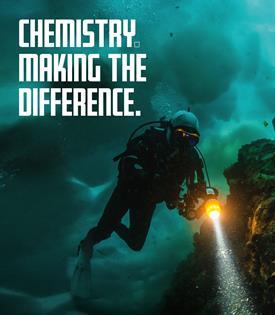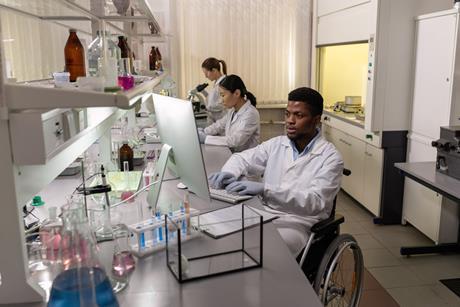L6 Laboratory scientist standard
How to prepare for your end point assessment
The EPA for the L6 Laboratory Scientist standard comprises two parts:
- Workplace synoptic project primary journal article and presentation with questioning
- Vocational competence discussion
This guide is designed to complement the information contained in the EPA plan for your apprenticeship standard and is not intended to replace conversations with your training provider, manager and EPAO. You can find your EPA plan by going to the Institute for Apprenticeships and Technical Education (IfATE) website.
Not sure if this guide is right for you?
Check out our introduction to end-point assessments to get started.
Preparing for a workplace synoptic project primary journal article, with presentation and questioning
To proceed through gateway, you will have completed a workplace synoptic project. Now, for your EPA, you will need to prepare a paper, in the style of a journal article, about that project, present it and answer questions about it.
From the start of your EPA period, you will have two months to write and submit your journal article to your EPA panel.
Check the assessment plan for your standard – it will tell you the format that your article should be in, what it should cover and which knowledge, skills and behaviours it should evidence.
Top tip: ‘The importance of understanding the grading criteria before writing the report cannot be overstated. If one area is overlooked or weak because you were unaware that it would come up at EPA while the rest exceeds the panel/assessor’s expectations the result will be a fail. The report must therefore follow the grading criteria – this should be considered at the start of the project design period well before the apprentice reaches Gateway.’
Simon Jukes, Director, EPAO for scientific apprenticeship standards
When you are writing your article, you should seek support from your supervisor at work or possibly your university tutor. They will be able to help you by proofreading it and offering constructive suggestions to improve it. The final article will be reviewed by the assessor from the EPAO, who will decide whether it has met the requirements and the next part of this assessment, the presentation to the EPA panel, should be arranged.
When you are preparing for your presentation to the panel, you should check your assessment plan, as it will tell you which points you should cover in your presentation, the format you can use and how long it should be.
Top tip: ‘My presentation was too long at 45 slides because my project had a lot of different sections to get through. This meant I had to rush through my presentation, and this impacted my delivery. I would say 30–35 slides should be the maximum. If projects are particularly large maybe focus on a few sections but be prepared to discuss other sections for the Q&A section.’
Amber Johnston, Laboratory Technician. Completed the level 6 laboratory scientist EPA.
If you are using slides, try to keep text on them to a minimum and consider using graphics to explain complex scientific ideas instead. You can talk around the images on your slide to show just how well you understand the science behind your work and what the results mean. You should discuss the impact of your work for the business and any recommendations that stem from your results. This could be improvements to their processes or next steps for the project, for example.
When you have drafted your presentation, practise presenting out loud, by yourself and with your supervisor, tutor or colleagues. This will help you to make sure that it is the right length, and you know what you want to say and how to say it, for each part. You can prepare notes, or even a full script, if you are worried that you will forget what to say. Your notes or script should be clear and easy to follow without losing your place. You should practise delivering your presentation using whatever prompts you have prepared. When it comes to getting ready for a presentation, there’s no such thing as too much practise!
Top tip: ‘When preparing for your EPA, discuss your project and role with co-workers, focusing on how you might explain the finer details (technical stuff) of your experiments, even to colleagues who have had no prior experience within your field. Where possible, present project findings to colleagues in company meetings. Start by presenting to other members of your team to help build confidence in your ability to speak in front of an audience and to gather as much useful feedback as possible. Once you feel more comfortable, challenge yourself to present in larger meetings to grow your confidence and so that you have a strong foundation of experience before sitting your assessments. If you’re not able to give presentations at work, attend presentations given by colleagues; pay close attention to how senior colleagues approach/explain their research in a clear and concise way and how they ensure that the core message of their presentation is well understood by the audience.When you are getting ready for your project discussion, make sure that you can:
- describe how you managed the project
- explain how the literature led you to your experimental design
- justify the methods selected and why they’re the most suitable
- list what skills were needed to complete the project
- show what problems were faced and how were they solved
- make recommendations for work that should be done if the project is continued.’
Peter Ferguson, Senior Scientist R&D. Completed the level 6 laboratory scientist EPA.
After you have given your presentation, you will be interviewed by the EPA panel, who will ask you questions on the themes outlined in the assessment plan. Check the assessment plan to understand specifically which knowledge, behaviours and skills the panel will be looking for you to demonstrate, and what you will have to do in order to get a pass or distinction. The questions will be ‘competency’ style questions. See the section on ‘ … for presenting your workplace report and questioning’ for advice on how to prepare for these sorts of questions.
Preparing for a vocational competence discussion
The point of a vocational competence discussion (VCD) is for you to show the assessor that you fully understand the requirements of your role as defined by the apprenticeship standard.
There are eight categories of question that the assessor can ask you, and they will ask you one question relating to each category. It will usually take around two hours. The assessor might take notes and might record the discussion.
Check the assessment plan for your standard – it will tell you what the eight categories of question are and may give some examples of the types of questions you could be asked. The assessment plan will tell you which knowledge, skills and behaviours the assessor will be looking for evidence of, and what you will need to do to get a pass or a distinction. You should answer each question with specific examples from your own experience in your role.
Top tip: ‘I very much prioritised my university work over my EPA. This caused me to suffer when my EPA was approaching as I was fairly unprepared. So, I would encourage anybody doing both at the same time to schedule in plenty of time for EPA evidence gathering. If I were to do it again, I would also practise my answers more and have a firmer idea of which evidence fits the criteria.’
Amber Johnston, Laboratory Technician. Completed the level 6 laboratory scientist EPA.
You will be able to bring your vocational competence evaluation log into the discussion and refer to it to help you find good answers for the questions. Make sure that your evaluation log is clearly laid out and easy to navigate so that you can quickly find the evidence that you want to talk about (you might want to edit it down a bit so it’s not too long). When you are looking at the evidence in your portfolio, think about which category of question it relates to and how you could incorporate particular pieces of evidence into your answers. Try to have more than one piece of evidence or example for each of the question categories so that you can talk about the one that best answers the question you have been asked. This will also help you to ensure that you have a specific example to talk about for each question, rather than only being able to talk hypothetically.
Your EPAO may have support materials, such as example questions, that you can request.
If you are unclear on the question, ask the assessor to repeat it so that you can be confident that you are giving them the information they need.
When preparing for your VCD, ask your workplace mentor or supervisor to go through some practise questions with you. You could try answering in the SHARE format (see previous section) to get used to making sure you cover all of the necessary detail, even if you don’t stick to this format on the day. When answering, talk in the first person (say ‘I’ instead of ‘we’) and keep the example about specific things that you did. You should also take time to familiarise yourself with your company’s policies and procedures and the regulations that relate to the work that they do.












